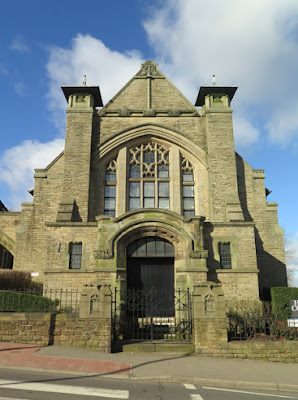 |
| Stone carving by Frank Tory |
Continuing my walk up and along Crookes and on to Northfield Road, I next stopped at Hale Court, the former St. Luke’s Wesleyan church and school, built at the turn of the century (1899-1900) by WJ Hale in a mixture of the Arts & Crafts and Art Nouveau styles, which was converted into a house and flats in 1990.
As with the Wesley Hall, the church has a very solid appearance, with the east window flanked by square towers that have leaded tent roofs and finials. The walling stone is the local gritty, medium grained Crawshaw Sandstone from the nearby Bolehills quarries, but the paler coloured massive sandstone used for the quoins and dressings is from the Ashover Grit near Matlock.
While looking around, I bumped into the owner, a former architect at Sheffield City Council, who informed me that a very similar sandstone from Matlock - possibly from Darley Dale - had been used to build the new small block of apartments at the rear of the property.
Although the style of the architect is quite austere, there is also a lot of elaborate stone carving by Frank Tory and Sons, the Sheffield based architectural sculptors whose work can be seen in numerous historic buildings around the city.
The angel-head imposts on either side of the east door are particularly impressive, with the carving of the sandstone here having very fine details, which is often not possible with some of the coarser materials used around the city.
This attention to fine detail in the stone carvings, which contrasts with the very bold buttresses, towers and other structural elements, seems to be characteristic of JW Hale’s work and is quite unlike other architecture that I have seen in Sheffield.






No comments:
Post a Comment